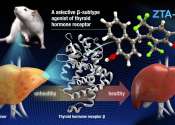How supercharged silk could help heal the heart
UNSW researchers have developed a new microgel made of moth silk that is designed to assist with tissue regeneration and could help people recover from heart attacks.
18 hours ago
0
3
UNSW researchers have developed a new microgel made of moth silk that is designed to assist with tissue regeneration and could help people recover from heart attacks.
18 hours ago
0
3

Nearly 100 wildfires are currently raging throughout the country, burning more than 2 million acres. The rising frequency of these fires poses a special concern for anesthesiologists—the potential for increased rates of ...
Aug 6, 2024
0
0

Nicholas A. Marston, MD, MPH, of the TIMI Study Group and Carl J. and Ruth Shapiro Cardiovascular Center at Brigham and Women's Hospital, is the corresponding author of a paper published in Nature Medicine, "Clonal hematopoiesis, ...
Aug 6, 2024
0
0

Scientists at Nagoya University in Japan have made a significant breakthrough in treating lipid disorders. They have developed a new compound, ZTA-261, which selectively binds to the thyroid hormone receptor beta (THRβ).
Aug 6, 2024
0
1

Having high blood pressure, specifically high diastolic blood pressure, was linked to a slightly higher odds of ever having migraine in female participants, according to a new study published in the July 31, 2024, online ...
Jul 31, 2024
0
0

Wearables measure several aspects of health, and heart rate variability might be one of those. It may be surprising when your device informs you that your heart rate variability is high or low, but what does it mean? Elijah ...
Jul 30, 2024
0
0

A recently unveiled cardiovascular disease risk calculator that measures a patient's risk for heart attack and stroke is better calibrated and more precise than its previous version, but if current treatment guidelines for ...
Jul 29, 2024
0
47

How a person's immune system responds to a protein called LL-37 may increase the risk of developing acute coronary syndrome, but the response may also serve as a potential target for future treatments. These findings come ...
Jul 25, 2024
0
3

Exercise is one of the best ways to reduce your risk of heart disease or having a second cardiovascular event, such as a heart attack or stroke.
Jul 24, 2024
0
0

They sit in the middle—the intermediate zone—where they are considered neither low nor high risk for having a heart attack or stroke. But heart disease may well be within striking distance, so how can we more accurately ...
Jul 22, 2024
0
5

Myocardial infarction (MI) or acute myocardial infarction (AMI), commonly known as a heart attack, results from the interruption of blood supply to a part of the heart, causing heart cells to die. This is most commonly due to occlusion (blockage) of a coronary artery following the rupture of a vulnerable atherosclerotic plaque, which is an unstable collection of lipids (cholesterol and fatty acids) and white blood cells (especially macrophages) in the wall of an artery. The resulting ischemia (restriction in blood supply) and ensuing oxygen shortage, if left untreated for a sufficient period of time, can cause damage or death (infarction) of heart muscle tissue (myocardium).
Classical symptoms of acute myocardial infarction include sudden chest pain (typically radiating to the left arm or left side of the neck), shortness of breath, nausea, vomiting, palpitations, sweating, and anxiety (often described as a sense of impending doom). Women may experience fewer typical symptoms than men, most commonly shortness of breath, weakness, a feeling of indigestion, and fatigue. Approximately one-quarter of all myocardial infarctions are "silent", that is without chest pain or other symptoms.
Among the diagnostic tests available to detect heart muscle damage are an electrocardiogram (ECG), echocardiography, cardiac MRI and various blood tests. The most often used blood markers are the creatine kinase-MB (CK-MB) fraction and the troponin levels. Immediate treatment for suspected acute myocardial infarction includes oxygen, aspirin, and sublingual nitroglycerin.
Most cases of STEMI (ST elevation MI) are treated with thrombolysis or percutaneous coronary intervention (PCI). NSTEMI (non-ST elevation MI) should be managed with medication, although PCI is often performed during hospital admission. In people who have multiple blockages and who are relatively stable, or in a few emergency cases, bypass surgery may be an option, especially in diabetics.
Heart attacks are the leading cause of death for both men and women worldwide. Important risk factors are previous cardiovascular disease, older age, tobacco smoking, high blood levels of certain lipids (triglycerides, low-density lipoprotein) and low levels of high density lipoprotein (HDL), diabetes, high blood pressure, obesity, chronic kidney disease, heart failure, excessive alcohol consumption, the abuse of certain drugs (such as cocaine and methamphetamine), and chronic high stress levels.
This text uses material from Wikipedia licensed under CC BY-SA